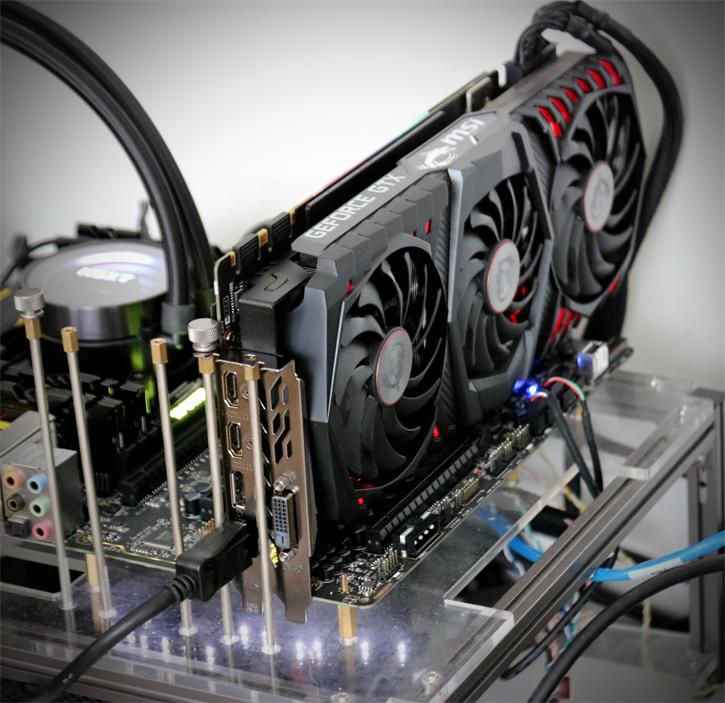Introduction
MSI GeForce GTX 1080 Ti Gaming X TRIO (11GB)
Raw brutal horsepower yet silent beyond believe
In this review we look at the new MSI GeForce GTX 1080 Ti Gaming X Trio edition. This GTX 1080 Ti comes customized in an all new jacket and is silent beyond believe thanks to a new triple fan solution tied to an improved cooling block. This graphics card comes customized with higher-factory clocks, a triple fan solution as well as a nice RGB setup. GTX 1080 Ti or not, this card passive up-to roughly 60 Degrees C and has a lot of hidden gems. Neither did it any warmer than 68 Degrees C either. The Gaming X Trio comes with new looks, it's styled a bit after the Lightning in RGB design elements with a combination that hints towards the Twinfrozr looks.
It is among the fastest graphics card your money can get you, the Nvidia GeForce GTX 1080 Ti based on Pascal architecture. Armed with 11 GB of GDDR5X graphics memory and an all new GP102-350 GPU, we are certain we're gonna break some records today. It has been eight months since Nvidia released the first GP102 based product, the Titan X. To date, a hugely impressive graphics card that will resemble what we review today and very similar on a lot of levels. Really, the 1080 Ti is the Titan X, just with one GB of that GDDR5X memory less and the one ROP partition tied to it. So let me break it down swiftly and quickly; the new high-end GTX 1080 Ti features 3584 CUDA Cores, 224 Texture Units, a 352-bit memory controller and 11 GB of faster (11 Gbps) GDDR5X memory. The card has the same "GP102" GPU as the TITAN X Pascal, but the GTX 1080 Ti was slightly reconfigured. Most interesting is the 352-bit wide GDDR5X memory interface, this was not expected. This translates into 11 memory chips on the card which run at 11 GHz (GDDR5X-effective), the memory bandwidth is 484 GB/s. This invokes the change in ROP count to 88 (from 96 on the TITAN X Pascal), and the TMU count of 224. The Pascal based unit is a bit of a beast alright, the GPU die size is 471 sq mm. If you look at the wider product stack, then a GeForce GTX 1080 has 2,560 shader processors, the GeForce GTX 1070 has 1,920 shader processors, the GeForce GTX 1060 has 1,280 of them. The Nvidia GeForce 1080 Ti has 3,584 shader processors active inside that GP102 GPU, I say active here deliberately as it still isn't even a fully enabled GPU. This means it is has 28 SMs active (28 streaming multi-processors x 128 shader cores (2x64). The cards will be equipped with fast GDDR5X memory as well for this 11 GB model. That memory is tied to a 352-bit wide bus locked in at 11 GHz (GDDR5X-effective). The combination of that memory type and clock frequency gives the 1080 Ti an effective memory bandwidth of 484 GB/s.
| GTX 1080 Ti FE | MSI GTX 1080 Ti Gaming X Trio (Silent Mode) | MSI GTX 1080 Ti Gaming X Trio (Gaming Mode) | MSI GTX 1080 Ti Gaming X Trio (OC Mode) | |
| GPU | GP102 | GP102 | GP102 | GP102 |
| Shader Cores | 3584 | 3584 | 3584 | 3584 |
| Base Clock | 1480MHz | 1480MHz | 1544MHz | 1569MHz |
| Boost Clock | 1582MHz | 1582MHz | 1657MHz | 1683MHz |
| gDDR5x | 11GB | 11GB | 11GB | 11GB |
| Power | 8+6 pin | 8+8-pin | 8+8 Pin | 8+8 Pin |
As I write this the new Trio cooled GTX 1080 Ti is running in the background running Time Spy, that huge new three fan cooler with a heatpipe / radiator design works alright as I cannot even hear the card even slightly and neither is it running hot whatsoever. The card clocks in at the gaming mode for defaults at a 1544 MHz base and 1657 MHz boost clock with memory at 1376 = 11 Gbps. The card comes with two 8-pin power header, included is a back-plate as well as a mounting strut to stabilize the card which MSI calls a "LAN Party Guard", so if you move around the card it'll be secure and tight preventing a sagging card due to movement. The card offers two HDMI ports and two DisplayPort outputs as well as DVI.
MSI is heading into a new direction with this card, and it is impressive alright. New looks, cool temps and cannot be heard with human ears really. This Pascal 102 GPU empowered product keeps that unit at, or just under, the 67~68 Degrees C marker depending on game load. The card at defaults clocks in at a base clock frequency of 1544 MHz and a Boost frequency of 1657 MHz. The card is designed in all black with some red elements. But let's head onwards to the next page, a go a little deeper underground.


